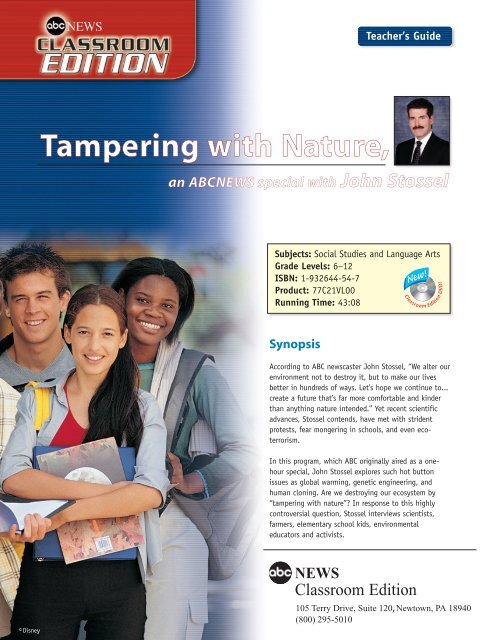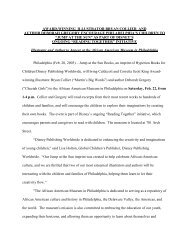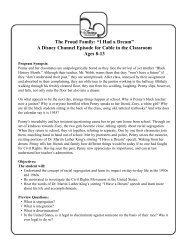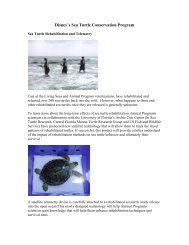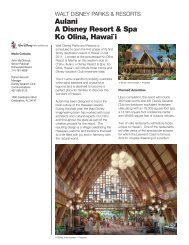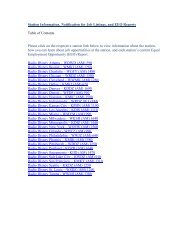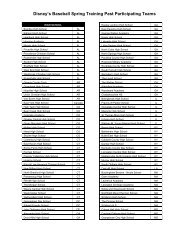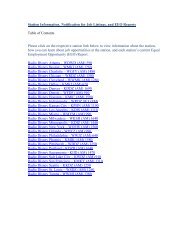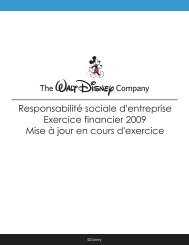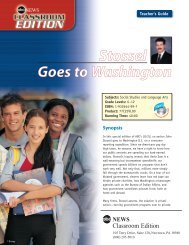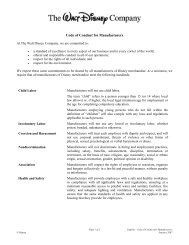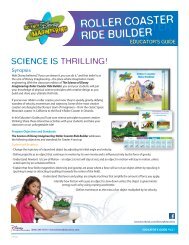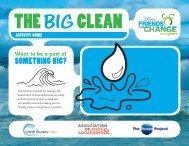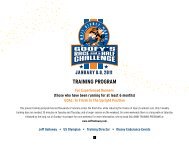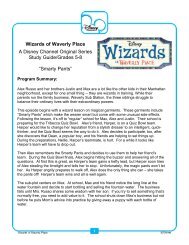You also want an ePaper? Increase the reach of your titles
YUMPU automatically turns print PDFs into web optimized ePapers that Google loves.
Postviewing QuestionsAsk these questions after viewing Chapter 1:Environmental Education?1. According to John Stossel, what would it belike to live a “natural life”?2. What are some examples of “tampering withnature”? Do you agree with John Stossel thataltering nature makes our lives better? Explainyour opinion.3. What does indoctrination mean? Do you thinkthe kids shown in this segment are beingeducated or indoctrinated? Did your teachersteach similar lessons when you were inelementary school? How did you feel about itthen? How do you feel about it now?4. After John Stossel interviewed one group ofkids, their parents rescinded permission forStossel to use the children’s images or voices.Why do you think the parents did this?Ask these questions after viewing Chapter 2:Global Warming.5. What is Greenpeace? Why does Patrick Moore, aformer Greenpeace director, criticize today’senvironmental activists? How does he answerthose who say that our forests are threatened?John Stossel mentions that Moore receivesmoney from the lumber industry. Do you thinkthis affects Moore’s opinions?6. Is the world’s climate actually warming? Howmuch? What does the acronym IPCC stand for?What does the IPCC chairman say about globalwarming? Do most scientists in the world agreewith the chairman’s views? Explain how youknow.7. According to Stossel and the scientists heinterviews, what are some arguments againstthe idea that global warming is a terriblethreat to humans? Why do some scientiststhink we should do to stop global warming?Why might taking such steps threaten the U.S.economy?8. What do you think about global warming? Is ita major threat or not? Explain why you think asyou do.Ask these questions after viewing Chapter 3:The Good Old Days?9. Would you like to make the Waipio Valley yourpermanent home? Why or why not? Why don’tmore people live there today?10. What does John Stossel hope to show in hisinterview with two Native Americans whoreenact Native American life long ago? What doyou think of Stossel’s questions and the interviewees’responses?11. What does the term romanticize mean? Do youthink most people romanticize “the old days”?Do you? Why or why not?Ask these questions after viewing Chapter 4:Genetically Engineered Food.12. What is plant crossbreeding and how does itcompare with today’s genetic engineeringprocesses? According to Stossel and his interviewee,which is safer? How can geneticengineering reduce the amounts of pesticidesthat farmers use?13. What are “Frankenfood” and “crack for cows”?Why do activists and others use these terms?14. Why do activists want dairy farmers to stopgiving growth hormones to their cows? What doyou think about this issue? Give reasons foryour opinion.15. What are some of the ways that environmentalactivists protest against genetically engineeredfood? Are these sorts of protests right orwrong? Explain why you think so.~5~©<strong>Disney</strong>
forests. Then they can discuss questions suchas the following:• Is it more important to preserve old growthforests or protect jobs that the loggingindustry creates?• Does logging threaten many plant and animalspecies, or do environmentalists exaggeratethis claim in order to raise money?• Is planting tree farms an adequate method ofreplenishing older forests that the lumberindustry cuts down?8. Interested students may want to visit andevaluate Patrick Moore’s website, Greenspirit. Askthem to spend some time reading variousarticles on the site. Ask them to also read thefollowing article from Wired magazine (postedon Moore’s website, as well): “Eco-Traitor” byDrake Bennett, March 2004 . Thenlead a discussion in which students summarizethe information they learned. Encourage themto discuss their reactions to Moore’s opinionsand to the Wired article about him. Also askthem to read aloud passages from the websiteor article that they feel are especially interestingor surprising.9. Have students do Internet and library researchon the history of the global warming controversyand the IPCC (Intergovernmental Panel onClimate Change). Students can use theirfindings to create a timeline of importantevents, legislation, and scientific discoveriesrelated to global warming. Sources mightinclude:• Global Warming by Kathiann M. Kowalski(Marshall Cavendish, 2003)• Global Warming: Understanding the Debateby Kenneth Green (Enslow Publishers,2002)• the IPCC’s website • History of Global Warming from NOW with BillMoyers on PBS Activities to accompany Chapter 3: The GoodOld Days?10. Stossel points out some unrealistic detailsconcerning Native Americans in the film Danceswith Wolves. Have students view this 1990movie. Note that the film is rated PG-13. Havestudents write movie reviews that discusswhether the film seems realistic or overlyromantic about Native Americans’ lives in thepast. Have them also consider the movie’s plot,dialogue, casting (choice of actors to playvarious roles), music, editing (how thedifferent scenes are pieced together), tone, andmessages, as well as actors’ performances. Askthem to research what life was like for NativeAmericans. Have students present their findingsand discuss.~8~©<strong>Disney</strong>
Activities to accompany Chapter 6:Give Me a Break.15. Have students read current and archived newsstories on PETA and its members’ activities. Ifnecessary, show students how to search fornews using Internet search engines such asgoogle.com. Students can retell news stories toclassmates. After discussing a PETA activity orstatement, students might vote on whether itseems justified or too extreme.16. Have students visit PETA’s website and that of the ASPCA (the American Societyfor the Prevention of Cruelty to Animals). After they peruse the two sites,have students write an essay comparing andcontrasting the two organizations.ResourcesIf you have access to the Internet, here are somesources of information on issues that John Stosseldiscusses on the DVD:All About Earth DayThis website includes a history of Earth Day, a kids’page, and a “Teachers’ Lounge.”< http://earthday.wilderness.org/history/>GeneWatch United KingdomAccording to its mission statement, “GeneWatch UKis a not-for-profit group that monitors developmentsin genetic technologies from a publicinterest, environmental protection and animalwelfare perspective.”Greenpeace USAPew Initiative on Food and BiotechnologyAccording to its mission statement, this organization“was established in 2001 to be an independent andobjective source of credible information on agriculturalbiotechnology.... [The group] advocates neitherfor, nor against, agricultural biotechnology.... [It] iscommitted to providing information and encouragingdebate and dialogue....”<strong>Tampering</strong> with <strong>Nature</strong>—a Partial Transcripthttp://abcnews.go.com/sections/2020/2020/stossel_tamperingwnature020614.html.~10~©<strong>Disney</strong>
Activity #1: Response ChartAs you watch <strong>Tampering</strong> with <strong>Nature</strong>, use the second column of the chart to record your reactions tothe information John Stossel reports, as well as the opinions and conclusions that he and othersexpress. Also jot down any questions that come into your mind as you view the show.TopicYour Own Opinions, Feelings, and QuestionsLink betweeneducation andkids’ fears aboutour planetGlobal warmingGeneticallyengineered foodCloning animalsand humansPETA (People forthe EthicalTreatment ofAnimals)~11~©<strong>Disney</strong>


